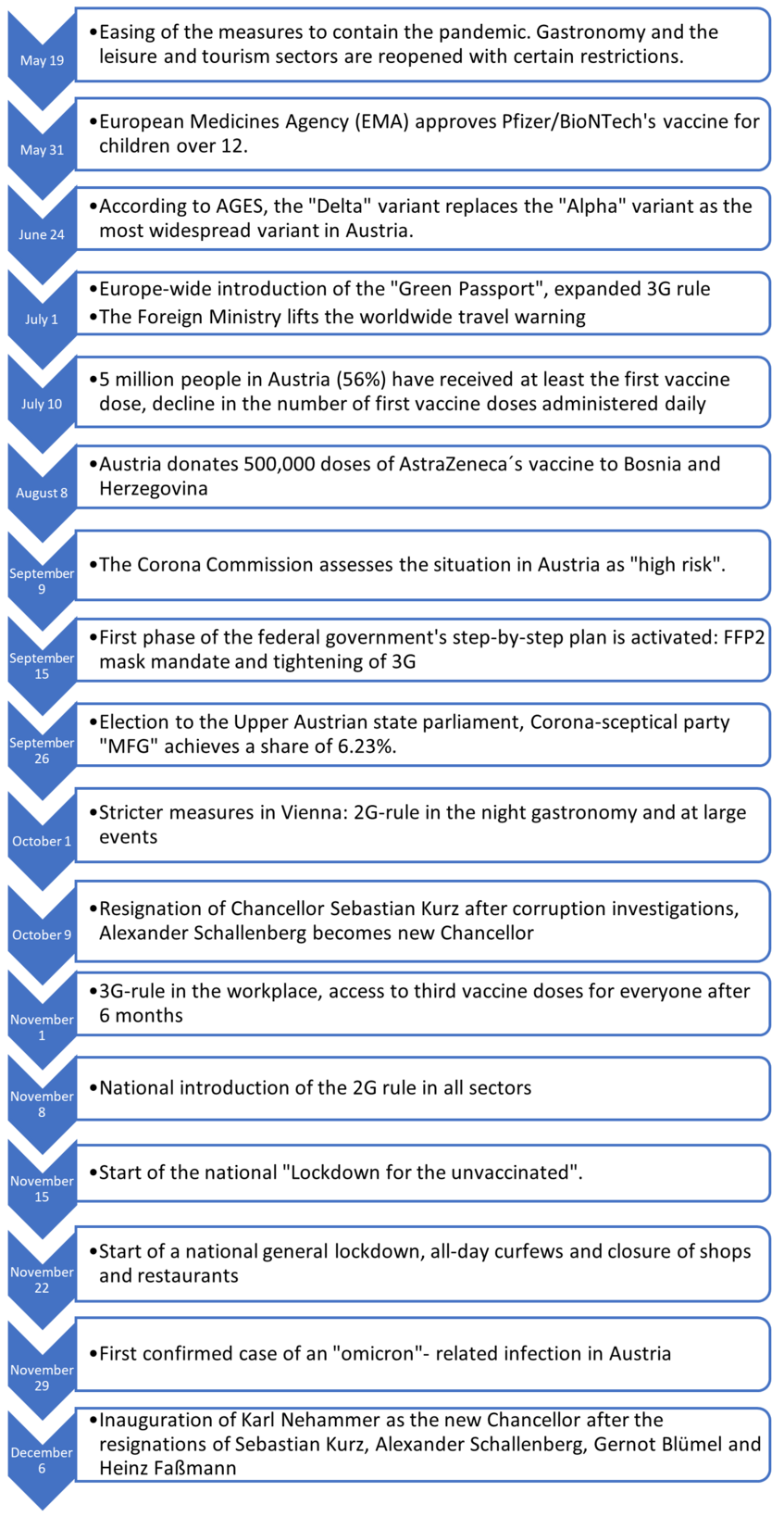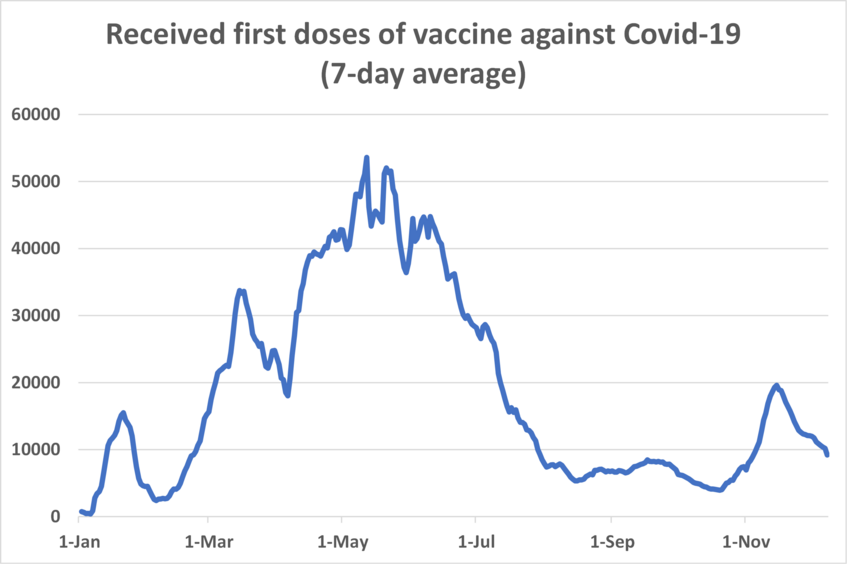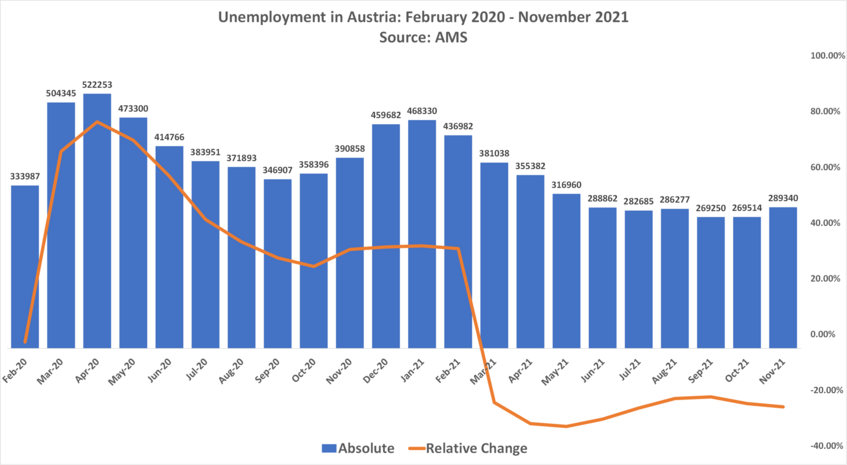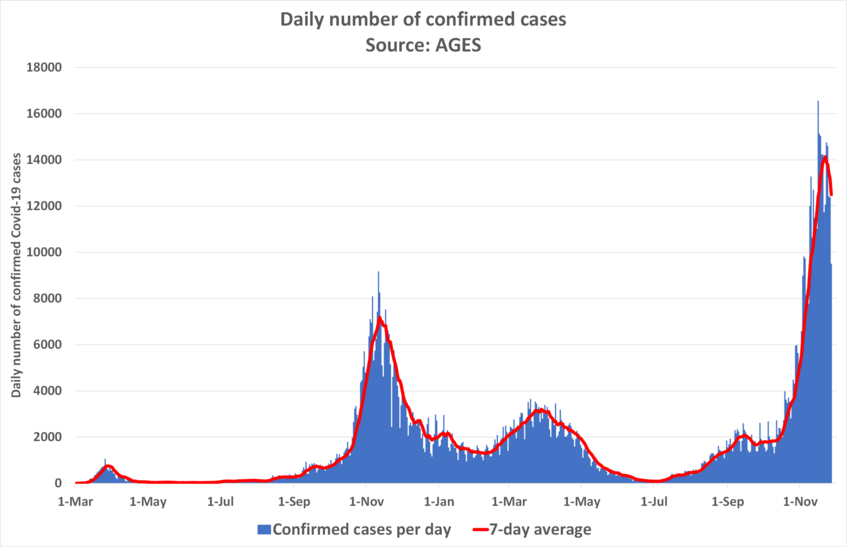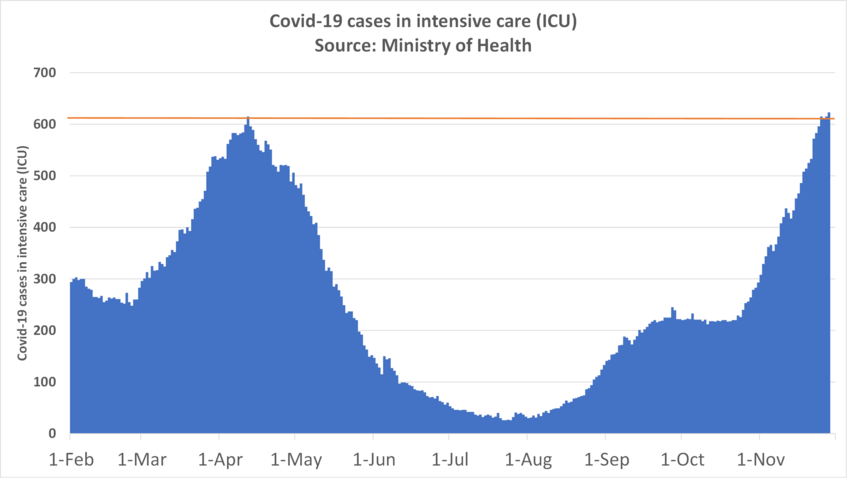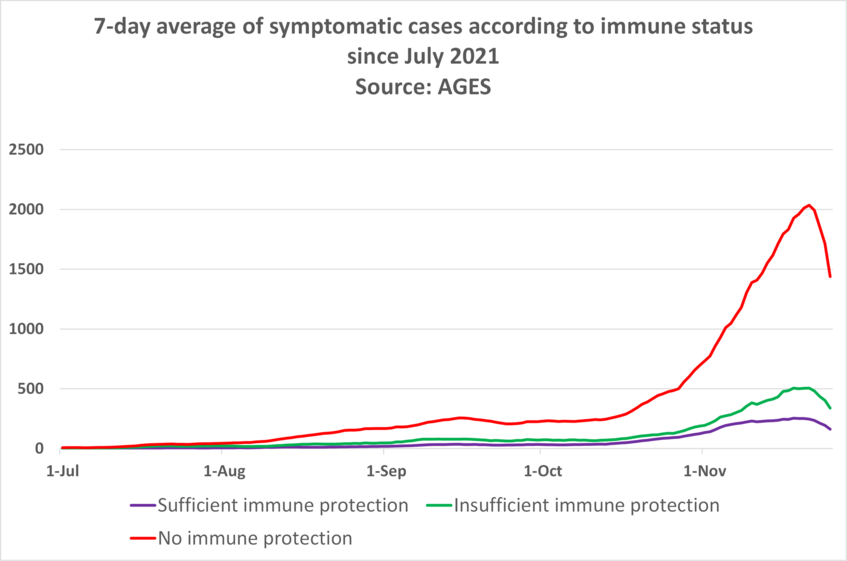17.12.2021 - PDF
Chronology of the Corona Crisis in Austria - Part 6: A "summer like it used to be", the way to the fourth wave, another lockdown and a vaccine mandate
- Between May and July 2021, falling infection numbers and the progress of the vaccination campaign allowed the government to ease the measures to contain the coronavirus pandemic. The so-called “Green Passport” as proof of low epidemiological risk and the “3G” rule for areas such as the gastronomy, the cultural sector and the leisure sector were introduced. The labour market situation had improved compared to the previous year.
- In late summer and autumn of 2021, the "Delta" variant increasingly spread and the fourth wave of infection hit Austria. In view of the rising infection numbers, new measures were introduced that increasingly restricted various areas of public life for unvaccinated people (extension of the 3G rule, new 2.5G and 2G rules).
- However, the number of daily infections increased rapidly after a period of stagnation, reaching the highest rate of newly reported COVID-19 cases in November 2021. The associated increase in the occupancy rate of intensive care units (ICU) led to the federal government's decision to implement another national lockdown from 22 November 2021. At the same time, the federal government announced a general vaccine mandate from 1 February 2022.
By Markus Pollak, Nikolaus Kowarz and Julia Partheymüller
This article documents the key events, developments and measures during the Corona crisis in Austria in the period from May to November 2021. Five preceding articles on the chronology of the Corona crisis in Austria have already covered the first lockdown and the initial phase of the crisis in spring 2020 and the subsequent withdrawal of the measures. In addition, the beginning of the second wave, the new lockdowns in autumn and winter 2020/21 and the third wave in spring 2021, regional lockdowns and the first months of the vaccination campaign were outlined. In this article we shed light on what has happened since then.
May-July 2021: Lockdowns, the vaccination campaign and the "Delta" variant
On 19 May 2021, the measures to contain the pandemic were significantly eased. From then on, the so-called "3G rule" applied to areas such as the gastronomy, the cultural sector and the leisure sector. The rule required costumers and visitors to provide proof of low epidemiological risk (vaccinated, recovered or tested). In view of falling infection numbers, the Austrian Corona Commission no longer classified any state as a "very high risk" area (red) on the Corona traffic light as of 27 May.
However, the first infections of the coronavirus variant B.1.617.2 known as "Delta" occurred in Austria at this time. Only a few weeks later, according to AGES, the "Delta" variant replaced the previously dominant "Alpha" variant B.1.1.7.
Originally, the federal government had announced that everyone willing to be vaccinated should receive a vaccination opportunity by the end of June 2021. However, this announcement could not be kept due to supply problems and the initially high demand for vaccination. Furthermore, in the midst of the vaccination campaign, the first vaccine (Pfizer/BioNTech) for children aged 12 to 15 years was approved by the European Medicines Agency (EMA) on 31 May 2021, further increasing the number of people eligible for vaccination. On 1 June, the federal government announced the goal that at least five million people in Austria should receive the first vaccine dose by the end of June. On 30 June, Chancellor Sebastian Kurz declared that the vaccine was no longer a scarce good and that the pandemic was "over for all vaccinated people". Already in April, Kurz had expected "a cool and intense time" for the summer. In June, Health Minister Wolfgang Mückstein said that in view of the easing of measures and the progress of the vaccination campaign, a "summer like it used to be'' would be possible. On 10 July, the federal government finally announced that 5,005,125 people in Austria had been vaccinated at least for the first time (about 56% of the total population). Chancellor Sebastian Kurz also declared that the crisis was now transforming "into an individual medical problem" and called upon individual responsibility. By this time, the number of first vaccine doses reported daily had already declined sharply (see Figure 2).
In June, the "Green Passport" was gradually introduced in Austria, which enabled vaccinated, recovered and tested people to prove their epidemiological status by means of a digital certificate. The standardised certificate was recognised throughout the EU as of 1 July.
On the same day, the Austrian Foreign Ministry also lifted the 15-month worldwide travel warning that had been introduced due to the Corona crisis.
On 1 July, the Ministry of Health issued a decree easing the measures that had been in place until then to contain the pandemic. The night gastronomy was opened, the mask mandate was eased and sports and cultural activities were possible again. At the same time, the "3G” rule, which had already been partially applicable since May, was extended to the areas affected by the easing of measures. Due to the increasing spread of the highly contagious Delta variant of the coronavirus (B.1.617.2), the federal government agreed about two weeks later on new restrictions in the night gastronomy. These were formalised in a decree of the Ministry of Health on 16 July and came into force on 22 July. At the same time, the mask mandate was lifted in large parts of Austria if the 3G rule was adhered to. However, the mask mandate was kept in Vienna, where the city government often adopted stricter measures than in the rest of the country.
The situation on the labour market developed increasingly positive. Absolute unemployment fell significantly in spring and summer 2021 due to seasonal factors. Moreover, the number of unemployed people had fallen to a significantly lower level in this period than in the months after the first lockdown in March 2020 (see Figure 3).
August-September 2021: Sluggish vaccination campaign and the start of the fourth wave
After the number of daily reported infections had fallen from the beginning of April until June 2021, the number of infections rose again significantly from July, and especially from August onwards (see Figure 4). While, according to the AGES Dashboard COVID19 [2], the 7-day incidence [1] was still 7.2 on 1 July 2021, it increased to 109.6 by 31 August 2021. At the same time, the vaccination campaign slowed down and only comparatively few first vaccine doses were administered.
In order to increase the strongly declining willingness to get the first vaccine dose (see Figure 2), the end of free testing opportunities, deductibles in health care for unvaccinated people as well as a vaccine mandate were discussed. However, a general vaccine mandate was repeatedly explicitly rejected by all parties represented in the Austrian Parliament, whereas it was conceivable to introduce a vaccine mandate for individual occupational groups. As the Austrian health authorities already had more vaccine doses than could be used in Austria at that time, 500.000 vaccine doses of the vaccine Vaxzevria (AstraZeneca) were donated to Bosnia and Herzegovina on 8 August 2021.
Authorities increasingly responded to regional outbreaks with local measures and regional travel restrictions. For example, on 11 August 2021, stricter measures were adopted for the entire territory of East Tyrol and travel restrictions for residents of Innervillgraten and Oberlienz were introduced. On 19 August, the Austrian Corona Commission announced that Austria is rated "medium risk" (yellow) due to the epidemiological development. Only the states of Burgenland and Carinthia continued to be assessed as "low risk" (green). Four days later, the Spanish Ministry of Health declared Austria a Corona risk area.
In the first two weeks of September, the increase in infection numbers continued, which resulted, with a slight delay, in a significantly higher occupancy rate of beds in intensive care units (ICU) in Austria (see Figures 4 and 5). On 9 September, the Austrian Corona Commission assessed Austria as "high risk" (orange) due to the infection dynamics. In the second half of the month, the increase in infection numbers and ICU occupancy did not continue and reached a "plateau", which was reflected in an effective reproduction number (R) of less than 1 [3].
In view of these developments, the federal government announced a step-by-step plan on 8 September, linking future measures to the occupancy rate of intensive care units (ICU). Since the first phase of the plan, which was linked to a 10 percent occupancy rate of the intensive care units, was to be reached as early as September, the reintroduction of a FFP2 mask mandate in public transport, supermarkets and drugstores was implemented by decree on 15 September. For unvaccinated people, the FFP2 mask mandate applied in all shops. The 3G rule would apply to all events with 25 or more people and the validity period of antigen tests was reduced from 48 to 24 hours. The development at that time was described by Chancellor Sebastian Kurz as a "pandemic of the unvaccinated people". In addition, on 17 September, the Austrian Healthcare Insurance (ÖGK) reintroduced the possibility of sick notes by phone call, which had only expired on 30 June.
On 26 September, the election for the Upper Austrian state parliament took place. The Corona-sceptical party "Menschen - Freiheit - Grundrechte" (MFG) achieved a share of 6.23% of the vote.
October 2021: Regional measures and the resignation of chancellor Sebastian Kurz
The regionalization of the measures to contain the pandemic, already witnessed in Part 5 of this chronology, continued during the fourth wave of infections. According to Health Minister Mückstein, the federal government was only responsible for the minimum treshold of measures while the states had to decide on the exact framework of policies. Due to the variety of policies in different states, several journalists described Austria as a hotchpotch (“Fleckerlteppich”) of measures. Throughout the crisis, Vienna often decided on stricter measures than the other states. On 1 October 2021, a decree came into force in Vienna that introduced a general FFP2 mask mandate in all shops, the "2G” rule (i.e. vaccinated or recovered) in the night gastronomy and large events (500 people or more) The "2.5G” rule (i.e. vaccinated, recovered, PCR-tested) applied for small events (25 people or more). In addition, antigen tests, which previously were valid for 24 hours, were no longer accepted.
In early October, house searches at the Chancellor´s office, the ÖVP party headquarters and the media group "Österreich" on 6 October triggered a serious crisis of the Austrian federal government. The house searches took place in the framework of corruption investigations by the Public Prosecutor's Office for Economic Affairs and Corruption (WKStA) against Chancellor Sebastian Kurz and several other accused individuals. In the days that followed, a number of chat protocols were published that politically burdened the Chancellor. Moreover, they were subject of further investigations by the WKStA. Vice-Chancellor Kogler (Greens) declared that he did not want to continue a coalition under Chancellor Kurz and talks were held between the Green Party leadership and the opposition parties SPÖ, FPÖ and NEOS to form an alternative government. Kurz then resigned as Chancellor on 9 October 2021. On 11 October, the outgoing Foreign Minister Alexander Schallenberg was then sworn in as the new Chancellor.
Only three days later, the Austrian Corona Commission declared Salzburg the first state to be a "very high" risk area (red) due to rising infection numbers. Lower Austria and especially Upper Austria were also increasingly affected by the increasing infection dynamics, which was also reflected in the Corona Commission's risk assessment only one week later. The risk in Burgenland was assessed significantly lower (yellow). Due to the high infection numbers in Salzburg, the state government of Salzburg introduced a general FFP2 mask mandate in shops on 15 October. In several districts in Salzburg, Upper Austria and Lower Austria, local travel restrictions were introduced in the second half of the month.
At federal level, Health Minister Wolfgang Mückstein and Labour Minister Martin Kocher responded on 20 October by announcing the introduction of the 3G rule in the workplace from 1 November, with a transition period until 14 November. By doing so, the Health Minister hoped to "ignite a vaccination boost" (“Impfturbo zünden”). Only a few days later, on 29 October, the federal government announced that as early as 15 November, the 2.5G (vaccinated, recovered, PCR-tested) rule in the workplace would replace the 3G rule. While the tightening was approved by most parties, the Austrian Trade Union Federation (ÖGB) as well as the Austrian Economic Chambers (WKÖ) criticised the lack of PCR testing opportunities in some states.
November 2021: 2G, lockdowns and the vaccine mandate
In November, Austria experienced a strong rise in the number of daily reported infections, hospitalisations and eventually COVID-19-related deaths. On 4 November 2021, the former peak (November 2020: 9,176) of new infections reported in one day was surpassed for the first time (9,817). On this day, the Austrian Corona Commission assessed the risk as "very high" (red) in every single state in Austria. From 14 November, the German authorities classified Austria as a "high risk area". Between 9 and 26 November, more than 10,000 new infections were reported daily (previous peak: 16,552 on 16 November, see Figure 4). Meanwhile, from the beginning of November onwards, less than 40 percent of the sources of infection could be investigated by contact tracing.
In November, Austria recorded one of the highest 7-day incidences worldwide. While the 7-day incidence had once reached a peak of 562.7 in 2020 (12.11.2020), the value clearly exceeded 1.000 between 18 and 26 November 2021. However, by breaking down the 7-day incidences by immunisation status, significant differences in the affectedness of different groups were observable (see Figure 6). Although the group of people without immune protection was clearly more affected by symptomatic infections, an increase among (partially) immunised (vaccinated/recovered) people could be witnessed in November as well.
Figure 6: 7-day incidence of symptomatic cases broken down by immunisation status over time (Source: AGES; The categories "Sufficient immune protection", "Insufficient immune protection" and "No immune protection" depend on the number of vaccine doses a person received as well as on natural immunity linked to past infections. The exact criteria can be found at www.ages.at/themen/krankheitserreger/coronavirus/.
In view of the increasing number of breakthrough infections, the Austrian health authorities relied on the third “booster” vaccine dose to restore vaccine effectiveness. Previously, the National Vaccination Panel (NIG) had recommended third vaccine doses 6 months after the second dose only for people who are older than 65. Otherwise, people under 65 were expected to get the third vaccine dose 9 to 12 months after the second dose. On 1 November, Vienna and Vorarlberg were the first states to allow third vaccine doses already 6 months after the second dose for all age groups, before the National Vaccination Committee (NIG) issued a similar national recommendation the following day. At the same time, the period of validity of the "Green Passport" after the second vaccine dose was reduced to 9 months. On 12 November, Vienna facilitated access to the third vaccine dose by reducing the minimum interval between the second and the third dose to 4 months.
Due to the increasing number of Covid-19 cases in intensive care units (ICU) (see Figure 5), the threshold for initiating phase 2 of the measures in the federal government's step-by-step plan was reached on 2 November. It was planned that, on 8 November, the 2G rule was extended to the night gastronomy and events with more than 500 people. In addition, antigen self-tests lost their validity. On 5 November, the federal government agreed with the state governors on further restrictions, already initiating the 4th stage of the step-by-step plan. Eventually, the 2G rule started on 8 November in the entire gastronomy, cultural sector, leisure sector, care facilities, services where the minimum distance cannot be respected and all events. At the same time, a general FFP2 mask mandate was introduced in shops. Although the education sector was exempted from the 2G rule, individual institutions started to tighten access rules as well.
In the days that followed, there were public disagreements about how to proceed. In view of the situation, Health Minister Mückstein advocated for further measures in Salzburg and Upper Austria and possible night-time curfews. The governors of Salzburg and Upper Austria ruled out such restrictions on 11 November after negotiations with the Ministry of Health. Salzburg's governor Wilfried Haslauer said that virologists would prefer "every single person in Salzburg and Austria to be locked in a room" - a statement that was sharply criticised by several scientists and classified as an expression of an "anti-science climate" in Austria.
In November, Chancellor Schallenberg repeatedly denied rumours about a possible upcoming general lockdown and emphasised that he was against restrictions of vaccinated people. On 12 November, in view of the continuing increase of infection numbers and similar announcements in Salzburg and Upper Austria, the federal government announced a vaccine mandate for health professionals and a national "lockdown for unvaccinated people". In addition to the current 2G regulations, this included all-day curfews for unvaccinated people. The lockdown for the unvaccinated, which received much international attention, came into force on 15 November, after it had been confirmed by the Parliament on 14 November.
Reports of overcrowded hospitals in some states became more frequent and preparations for the triage in some hospitals were initiated. Therefore, the governor of Upper Austria, Thomas Stelzer, announced a general lockdown in Upper Austria and Salzburg from 22 November only three days after the start of the national lockdown for unvaccinated people. One day later, at a meeting in Tyrol, the state governors and the federal government decided on a national general lockdown for vaccinated and unvaccinated people, which should start on 22 November and end on 12 December. The lockdown was formalized by decree on 21 November. Similar to previous lockdowns, shops, gastronomy and the leisure sector were closed and all-day curfews were imposed. Work from the home office was recommended for everyone wherever possible. In contrast to the lockdowns in the previous year, however, primary and secondary schools were not closed, although students were both excused and, where possible, encouraged to stay away. This regulation led to a public debate about school closures and the role of schools in the pandemic dynamics. According to media reports, about 75% of primary and secondary school students in Austria went to school on the first day of the lockdown. However, in Upper Austria (60-70%) and Salzburg (50%), particularly few students went to school, while in other states up to 90% of students were present. Another exception to the general closure of the leisure sector concerned ski lifts.
At the same time, on 19 November 2021, the federal government announced the introduction of a general vaccine mandate, which would come into force on 1 February 2022. The government justified the vaccine mandate with the currently insufficient vaccination rate, which was inhibiting efforts to contain the pandemic. Moreover, the low number of daily first vaccine doses administered (see Figure 2) and the disproportionately high number of unvaccinated people affected by the fourth wave of infection (see Figure 6) were key factors in the decision. The general vaccine mandate, which received much international attention, led to controversial discussions about the legitimacy and functionality of such a policy. The exact draft law for the vaccine mandate is expected in December 2021. Furthermore, in order to increase the willingness to get vaccinated through positive incentives, the Austrian Broadcasting Corporation ORF announced a national lottery for vaccinated people on 22 November.
In November, it was reported that some people who were sceptical about vaccination had used the prescription deworming drug Ivermectin to treat their COVID-19 infections, leading to poisoning in several cases. FPÖ chairman Herbert Kickl, who repeatedly spoke out against Covid-19 related measures and the vaccine, had previously recommended the use of the drug. The measures taken in November also led to a number of protests against the restrictions and the vaccine mandate. The largest protests took place in Vienna on 20 November and 4 December, with around 40,000 people participating in each.
On 25 November, the European Medicines Agency (EMA) decided to approve the Biontech/Pfizer vaccine for children at the age of 5 years and older. At the end of November, the World Health Organisation (WHO) classified a new, rapidly spreading "Omicron" variant of the coronavirus as a "Variant of Concern", as it might be more infectious than the previously dominant Delta variant and might better circumvent existing immune protection. On 29 November, the first case of infection linked to the new variant was confirmed in Austria.
On 2 December, former Chancellor Sebastian Kurz withdrew completely from politics in the light of ongoing corruption investigations. His announcement was followed by a series of resignations by members of the government nominated by the ÖVP. On 6 December, in a government reshuffle, the former Minister of the Interior Karl Nehammer was sworn in as Chancellor, as well as four new ministers and a state secretary.
Summary and conclusion
The period from May to July was characterised by openings, declining infection numbers and an acceleration of the vaccination campaign. As the vaccination rate increased, access to different areas of public life became increasingly linked to vaccination and testing, referred to as 3G, 2.5G and 2G rules.
Between August and October, the fourth wave of infection began to spread in Austria. The daily reported infections, which were mainly linked to the delta variant, reached a period of stagnation lasting from mid-September to mid-October. The federal government and certain state governments (especially Vienna) reacted with new measures, this time increasingly focusing on restrictions for unvaccinated people who were disproportionately affected by the pandemic dynamics.
In November, the fourth wave of infections peaked, leading to hospitals and intensive care units being overwhelmed and the triage being implemented in some states. Following the introduction of a national 2G rule and a "lockdown for the unvaccinated people", the federal government introduced another general lockdown on 22 November, which also applied for vaccinated people. At the same time, the federal government announced a general vaccine mandate from 1 February 2022, causing a series of protests.
The developments of the last 6 months cast doubts on the widely expressed hope that the Corona crisis in Austria would be over (soon). Above all, the widespread lack of willingness to vaccinate, societal tensions and the yet unclear effects of the new virus variant Omicron will continue to keep decision-makers busy. The coming months will show how the planned general vaccine mandate will affect the further development of the Corona crisis in Austria.
Markus Pollak works as student assistant at the Institute for Economic Sociology at the University of Vienna on the Austrian Corona Panel Project. He is studying political science for his Master's degree.
Nikolaus Kowarz works as student assistant at the Institute of Governance at the University of Vienna and is studying Political Science for his Master's degree.
Julia Partheymüller works as Senior Scientist at the Vienna Center for Electoral Research (VieCER) at the University of Vienna and is a member of the project team of the Austrian National Election Study (AUTNES). She received her doctorate in social sciences at the University of Mannheim and studied political science at the Free University of Berlin and the University of Hamburg.
Footnotes
[1] The seven-day incidence rate represents the incidence of Covid-19 infections within 7 days calculated per 100,000 persons for reasons of comparability.
[2] All data on confirmed infections, deaths and growth rates in this article refers to the official data and the calculation method of the Austrian Ministry of Health, the Austrian agency for health and food security GmbH as well as to the AGES Dashboard COVID 19: https://covid19-dashboard.ages.at/?l=en
The figures may therefore differ from those of other sources. e.g. COVID-19 Dashboard by the Center for Systems Science and Engineering (CSSE) at Johns Hopkins University (JHU): https://coronavirus.jhu.edu/map.html
[3] R indicates how many people an infected person infects on average. If the value is above 1, it means that there is a net increase in confirmed COVID-19 infections in Austria. Here you can find a more detailed description of the effective reproduction number: www.zeit.de/wissen/gesundheit/2020-04/coronavirus-deutschland-reproduktionszahl-infektionen
Related Blog Posts
Chronology
- February - March 2020: Blog 51 (EN) - Chronology of the Corona Crisis in Austria - Part 1: Background, the way to the lockdown, the acute phase and economic consequences
- April - June 2020: Blog 60 (EN) - Chronology of the Corona Crisis in Austria - Part 2: From the first easing of measures towards restoring normality
- July - September 2020: Blog 79 (EN) - Chronology of the Corona Crisis in Austria - Part 3: A calm summer and the beginning of the second wave
- October 2020 - January 2021: Blog 100 (EN) - Chronology of the Corona Crisis in Austria - Part 4: Lockdowns, mass testing and the launch of the vaccination campaign
- February 2021 - May 2021: Blog 112 (EN) - Chronology of the Corona Crisis in Austria - Part 5: Third Wave, Regional Lockdowns and the Vaccination Campaign
English Summaries
- COVID-19 affects us all — unequally. Lessons from Austria
- From Acute Crisis to Long-Term Coping?
- The Coronation of Austria: Part 3
- The Coronation of Austria, Part 4
- The Coronation of Austria, Part 5: Time for a syndemic perspective?
- The Coronation of Austria: Part 6
- The Coronation of Austria: Part 7
- The Coronation of Austria: Part 8
- The Coronation of Austria, Part 9: Postal Votes, Polarisation, and Protecting Others
- The Coronation of Austria: Part 10
- The Coronation of Austria: Part 11
- The Coronation of Austria: Part 12
- The Coronation of Austria: Part 13
- The Coronation of Austria: Part 14
- The Coronation of Austria: Part 15
- The Coronation of Austria: Part 16

